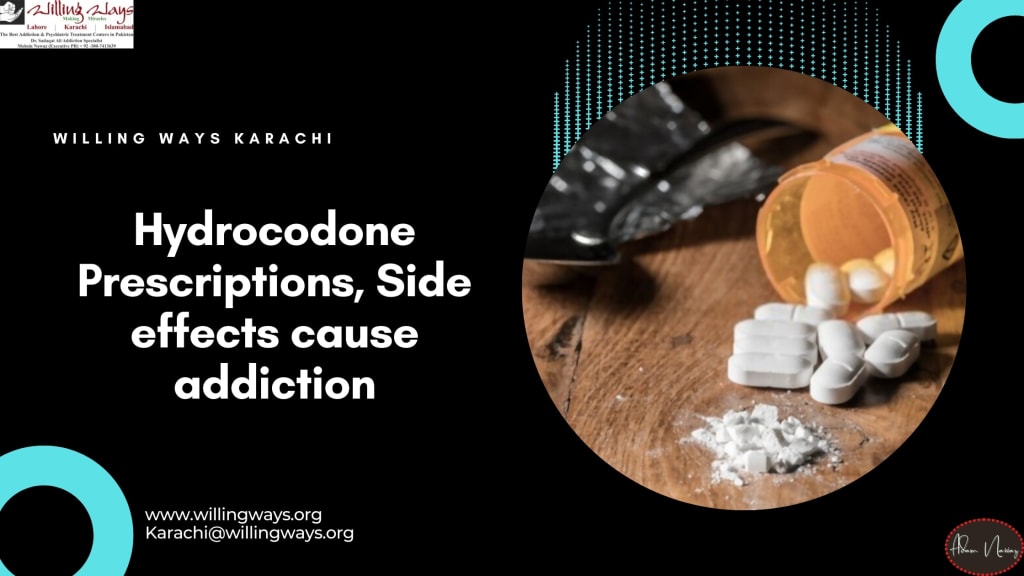Hydrocodone Prescriptions, Side effects that Addiction obtained
Hydrocodone is a semi fabricated opiate (narcotic) obtained from two of the typically happening tranquillisers, codeine and Theban

Over here at the best addiction treatment center in Karachi, the experts are doing their best for the addiction treatment of many patients. For your information, thebaine is a poisonous alkaloid that causes fits like What is Vicodin Addiction people also come to the addiction treatment center to ask about this type of addiction’s symptoms achieved by strychnine. A high probability of hydrocodone propensity has been known since its improvement in the 1920s by Willing ways Karachi, the expert of addiction treatment.
Hydrocodone is recommended for the alleviation of moderate to modestly extreme agony. It is taken orally as a functioning opiate pain relieving (pain reliever) and an enemy of tussive (hack suppressant). The relief from discomfort by Hydrocodone is remembered to include fringe and focal activities, yet the specific mechanism(s) stays obscure.
Because Hydrocodone acts on the brain, its significant side effects are central and include dizziness, drowsiness, nausea, vomiting, euphoria, lightheadedness and confusion. Although these effects are labelled as "side" effects, they are the effects; they have been marked as "side" effects because they are the undesirable effects associated with the drug. The high probability of hydrocodone Addiction has been known since its development in the 1920s.
As per the Medication Implementation Office (DEA), Hydrocodone is the most often endorsed sedative in the US, with almost 130 million solutions for hydrocodone-containing items apportioned in 2006. There are a few hundred brand names and nonexclusive hydrocodone items promoted. All are blend items, and the most often endorsed mix is Hydrocodone and acetaminophen (Vicodin®, Lortab®, Lorcet®).
Over the last twenty years, sales and consumption of Hydrocodone have increased significantly. Besides being used as an efficient pain killer, Hydrocodone's illicit use has also increased considerably. Hydrocodone is available in various forms, including tablets, capsules and syrup.
Hydrocodone Prescription Dose and Preparations
The dose of Hydrocodone depends on the intensity of the pain and the tolerance level of the patient. However, tolerance to Hydrocodone typically develops with continued use, and much higher doses are required to decrease pain. In addition, increased drug use increases the incidence of side effects and the chance of addiction resulting in overdose.
Hydrocodone is always combined with acetaminophen/ibuprofen/antihistamine as a prescription. The dose of acetaminophen may vary from 350-650 mg. The amount of Hydrocodone may range from 5-15 mg. Various combinations of this mixture are available. Hydrocodone is usually taken 3-4 daily to relieve moderate or severe pain. The dose of Hydrocodone should not exceed more than 40 mg in a day, and the amount of acetaminophen should not exceed 3-4000 mg per day (8-12 tablets per day).
With mixtures of Hydrocodone with toxins like thebaine, a poison similar to strychnine, and acetaminophen, known for being the most common cause of drug-induced liver disease, it's no wonder a hydrocodone addict experiences these effects. In the United States, pure Hydrocodone is rarely prescribed and is considered a Schedule II drug, requiring a DEA certificate for a prescription. Hydrocodone, when it is defined as acetaminophen, is classified as a Schedule III drug and available only with a prescription.
Hydrocodone Formulations
Generic names for Hydrocodone include Vicoden, decoding, hycodan, hycomine, Lorcet, Lortab, Norco, Nova hex, hydro co, Tussionex and Vicoprofen. Therapeutic combinations of Hydrocodone and acetaminophen are available as Vicodin and Lortab. When combined with aspirin, the product is sold as Lortab ASA), Vicoprofen with ibuprofen, and hycodan combined with an antihistamine.
Hydrocodone Unfavorable Impacts
Most unfavourable responses often incorporate tipsiness, unsteadiness, sedation, sickness, and retching. These impacts are expected when the individual is dynamic, and these antagonistic responses might be eased, assuming the patient rests.
Hydrocodone is known to hinder judgment and can cause mental laziness and obfuscation. Hydrocodone should be utilized with special consideration in patients with a head injury as it can cloud the side effects of a head injury. Hydrocodone can create unfavourable responses, which might darken the clinical course of patients with head wounds.
Hydrocodone Poisonousness
To keep people from taking extreme Hydrocodone, all suitable hydrocodone items are planned with acetaminophen. Acetaminophen isn't excellent when taken in high dosages. Notwithstanding, because acetaminophen is dissolvable in water, it tends to be removed in warm water, leaving just the sober type of Hydrocodone accessible for utilization.
Following intense over-measurements, harmfulness might result from Hydrocodone or acetaminophen. With a central sense of dealing with hydrocodone habit, it will be seen that the body treats drugs, which are harmful as toxic substances, since they are positioned to deal with poisons productively through a separating interaction known as the liver and kidneys. The toxin is then utilized and handled into metabolites which ought to be pushed out of the body using the perspiration organs or potentially urinary parcel.
Over the long run, one will create a physical or potentially mental reliance on Hydrocodone. Any individual who has been involved in it for a specific period — whether as a patient or as a junkie — will encounter some awkward hydrocodone withdrawal if the medication is stopped out of nowhere — as the body will go into shock, because of not having the poisoning impact the substance responses of the body as it has become acquainted with working with.
Side effects of hydrocodone withdrawal can show up as fast as a couple of hours after the client's last portion, or they not start for an entire day. They can include:
Excessive sweating & yawning;
- Runny nose & eyes, bouts of diarrhea and vomiting;
- Shivering & goosebumps
- Muscle aches & cramps
- Restlessness & insomnia
- Irritability & Anxiety
- Loss of appetite
- Powerful cravings for the opioid that persist long after the withdrawal symptoms have passed.
About the Creator
Willing Ways
Willing Ways is the Best addiction treatment center in Pakistan. We are the pioneer in drugs & alcohol treatment centers with outstanding services and a history of 43 years. We deliver quality writing that is beneficial for you.
Enjoyed the story? Support the Creator.
Subscribe for free to receive all their stories in your feed. You could also pledge your support or give them a one-off tip, letting them know you appreciate their work.






Comments
There are no comments for this story
Be the first to respond and start the conversation.